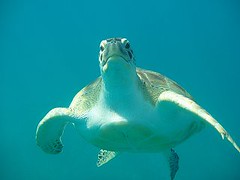The Great Turtle Race!
 Here’s a great story about how the combination of satellite tracking technology and the Internet can be used to raise awareness about conservation efforts around the world.
Here’s a great story about how the combination of satellite tracking technology and the Internet can be used to raise awareness about conservation efforts around the world.
The Leatherback Sea Turtle is the biggest of all living turtles and the world’s fourth-largest reptile, reaching more than 6 feet in length and weighing up to 2000 lbs. It is also listed as endangered worldwide by the U.S. government, with the global population of female leatherbacks plunging from an estimated 115,000 in 1980 to fewer than 43,000 today.
Ranging throughout the Pacific, Atlantic and Indian oceans, leatherbacks worldwide are threatened not only by coastal development and loss of habitat, but by ocean pollution and "floating plastic bags or sheets which they mistake for jellyfish — a staple of their diet." 90 percent of the leatherbacks have vanished and the species may disappear within 10 years due to illegal poaching of their eggs, according to conservationists.
To draw attention to the plight of the leatherbacks, conservationists yesterday launched the Great Turtle Race.
The AP reports:
Biologists will switch on satellite trackers strapped to the backs of 11 female leatherback turtles on Monday, starting what conservationists have dubbed the "Great Turtle Race" to raise awareness of a species threatened with extinction.
Sponsored by U.S. and Costa Rican environmental groups and businesses, the race will track the turtles on their annual 1,200 mile journey from Costa Rica’s Pacific coast to the Galapagos Islands….
Most of the competing turtles are expected to be in the water by Monday after laying their eggs on the beach at Playa Grande in Costa Rica.
The Web site features virtual trading cards with caricatures of the turtles with names like Freedom, Windy and Stephanie Colburtle after U.S. comedian Stephen Colbert of Comedy Central fame. It also has stats on their egg-laying history…
Ten race sponsors — including Yahoo Inc., Plantronics Inc., Philadelphia’s Drexel University and Dreyer’s Ice Cream — donated $25,000 each to purchase the tracking equipment and protect nesting areas from development.
Leatherbacks aren’t the only sea creatures that are getting tagged with satellite trackers to raise awareness and scientific knowledge about the world’s oceans. The Census of Marine Life has a great site, Tagging of Pacific Pelagics, where users can track tracking projects of a variety of species and view real time data of the movement of sharks and other animals in the Pacific. And NASA is tracking sea lions to gain a better understanding of the world’s oceans.
For ease of use and entertaining presentation — especially for a younger audience — it’s hard to beat the Great Turtle Race website. Check it out, because those turtles are, um, making some quick tracks.